At the 12th Monaco Energy Boat Challenge, Yacht Club de Monaco hosted the Advanced Yachting Technology Conference on this Thursday morning to discuss major technology and environmental trends in the maritime and yachting sector. Researchers, industry players and experts shared their visions and presented the latest advances in innovation, artificial intelligence, decarbonized propulsion and cybersecurity. All discussions are available on replay: https://energyboatchallenge.com/webtv-mebc/.
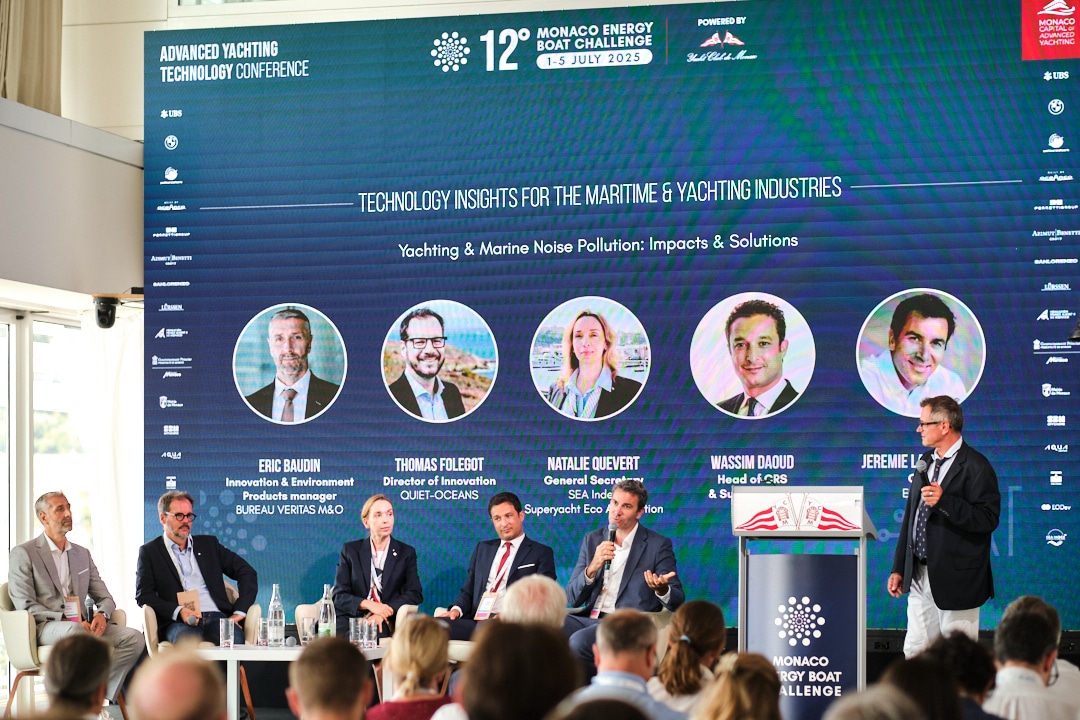
Underwater noise pollution remains a key environmental issue yet to be explored by the yachting industry. Eric Baudin, Innovation & Environment Products Manager at Bureau Veritas, noted that regulations around noise pollution are being ramped up, citing finalisation of ISO standards for measuring noise in shallow waters, technical work by the European Commission, and more recently signing of a coalition of 37 countries to fight for quieter oceans at the United Nations Ocean Conference in Nice. The International Maritime Organization (IMO) guidelines already stipulate a clear methodology to “establish an inventory, measure the noise footprint of ships, set goals, implement reduction solutions and assess their effectiveness,” he said. In particular, it was pointed out that coastal boating has a significant acoustic impact, especially in sensitive areas, which has a direct effect on local marine fauna.
Thomas Folegot, Director of Innovation at Quiet Oceans, presented the Noise Ship Index, a tool enabling ship owners to track their noise reduction progress and be recognised for each target met. Quiet Oceans also deploys the SMART URN buoy that automatically measures the noise footprint of ships at sea, including off Fos-sur-Mer (Marseille), Genoa, and soon in the North Sea.
The SEA Index® and Bureau Veritas took the opportunity to formalize their collaboration on Underwater Radiated Noise (URN) by unveiling the first step in the development of a voluntary rating system for superyachts. This joint initiative aims to raise awareness among yacht owners, captains, designers and industry players of the growing impact of underwater noise for ocean health, thereby laying the foundations for mitigating it in the yachting sector. “Since the start of the SEA Index®, we have known about the link between noise and energy intensity of ships. We are now adapting the methodology to the reality of superyachts,” explained Natalie Quévert, General Secretary of the SEA Index®, a benchmark tool set up by YCM in collaboration with Credit Suisse (a UBS Group brand) to measure the carbon impact of yachts over 24 metres.
Wassim Daoud, CSR and Sustainability Manager at PONANT, shared the French cruise line’s initiatives, namely acoustic signature measured on the Jacques Cartier, hydrophones installed on seven ships, and the Swap2Zero project aimed at having a zero-emission-zero-noise ship, stressing that “operational protocols remain the best measures: reducing speed, cutting engines in sensitive regions and choosing the right equipment”. Finally, Jérémie Lagarrigue, CEO of EODev, emphasised the importance of acting on all these levers: hull shape, choice of propellers, and electric and hydrogen solutions. “Just by changing the propeller design can cut underwater noise by 50%,” he said. He also discussed lessons learned in other sectors like the mining industry where electrification has reduced noise pollution and accidents ten-fold.
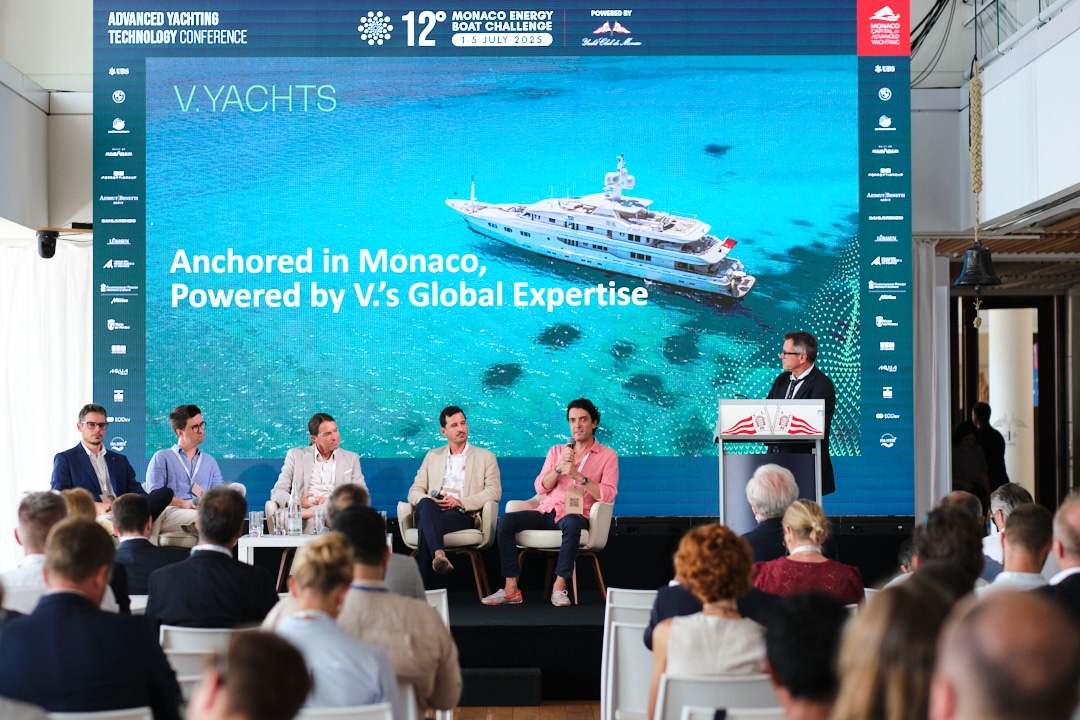
Given the urgent need to decarbonize shipping, initiatives are multiplying, starting with those that combine onboard renewable energy sources. Keisuke Kimura, Deputy Technical Director at MOL LTD, presented the Wind Hunter project combining wind power and hydrogen production at sea. A first demonstration is underway in Japan with the development of a 70m vessel. “Our ultimate goal is to build a green hydrogen supply chain,” he concluded. But other solutions are also envisaged to cut the carbon footprint of existing boats starting with CO2 capture on board. For Aakash Dua, Regional Business Development Director DNV, the debate goes on. While carbon capture is proven on land, its application at sea, particularly on the smaller vessels remains problematic. “Costs, space constraints and storage still pose serious challenges, particularly for yachting”, he said. A view shared by Franck Fourrier, Growth Technical Director at SBM Offshore, based on the company’s experience in offshore oil and gas. “Transposing these technologies onto moving ships is a completely different challenge,” he pointed out. Smaller scale prototypes are however under development.
Langh Tech takes a different approach. Laura Langh-Lagerlöf, CEO and Founder of Langh Tech, described a solution based on caustic soda that captures CO2 and transforms it into soda ash, a reusable product. “It’s not about revolutionising everything, but adapting technologies to the reality of each vessel,” she said, highlighting the pertinence of this option for short journeys and frequent stopovers.
Given the urgent need to decarbonize shipping, initiatives are multiplying, starting with those that combine onboard renewable energy sources. Keisuke Kimura, Deputy Technical Director at MOL LTD, presented the Wind Hunter project combining wind power and hydrogen production at sea. A first demonstration is underway in Japan with the development of a 70m vessel. “Our ultimate goal is to build a green hydrogen supply chain,” he concluded. But other solutions are also envisaged to cut the carbon footprint of existing boats starting with CO2 capture on board. For Aakash Dua, Regional Business Development Director DNV, the debate goes on. While carbon capture is proven on land, its application at sea, particularly on the smaller vessels remains problematic. “Costs, space constraints and storage still pose serious challenges, particularly for yachting”, he said. A view shared by Franck Fourrier, Growth Technical Director at SBM Offshore, based on the company’s experience in offshore oil and gas. “Transposing these technologies onto moving ships is a completely different challenge,” he pointed out. Smaller scale prototypes are however under development.
Langh Tech takes a different approach. Laura Langh-Lagerlöf, CEO and Founder of Langh Tech, described a solution based on caustic soda that captures CO2 and transforms it into soda ash, a reusable product. “It’s not about revolutionising everything, but adapting technologies to the reality of each vessel,” she said, highlighting the pertinence of this option for short journeys and frequent stopovers.
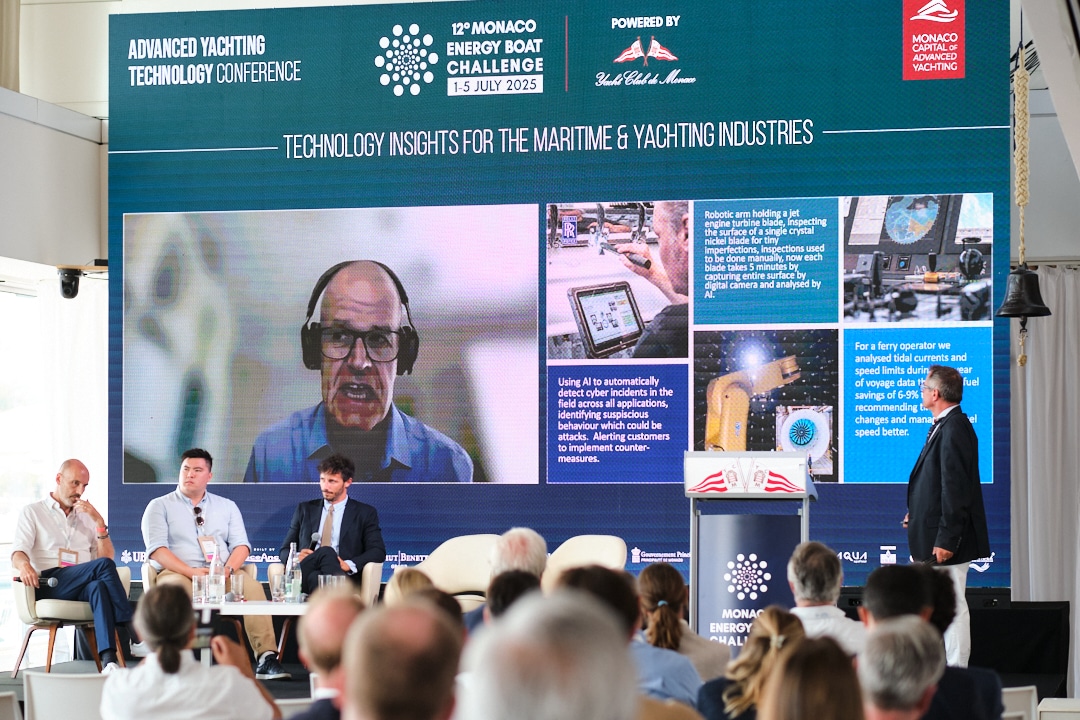
Iacopo Senarega, R&D Project Manager at the Azimut|Benetti group presented the Italian shipbuilder’s sustainability and technological innovation strategy. “We’re convinced we must drive the rules and standards of our industry together”. The yard is focusing in particular on hydrodynamic efficiency, electrification, alternative fuels, and reducing consumption when docked and at anchor.
For Vivien Delaunay, Executive Director of UBS Monaco, decarbonizing yachting is no longer just an ecological imperative, it’s an asset valuation issue: “The question is simple: will the yacht I build, finance or own today retain its value tomorrow?”, he summed up. UBS is supporting this transition through its partnership with the Prince Albert II of Monaco Foundation and involvement in the SEA Index® and recent launch of a US$ 250 million fund dedicated to the blue economy.
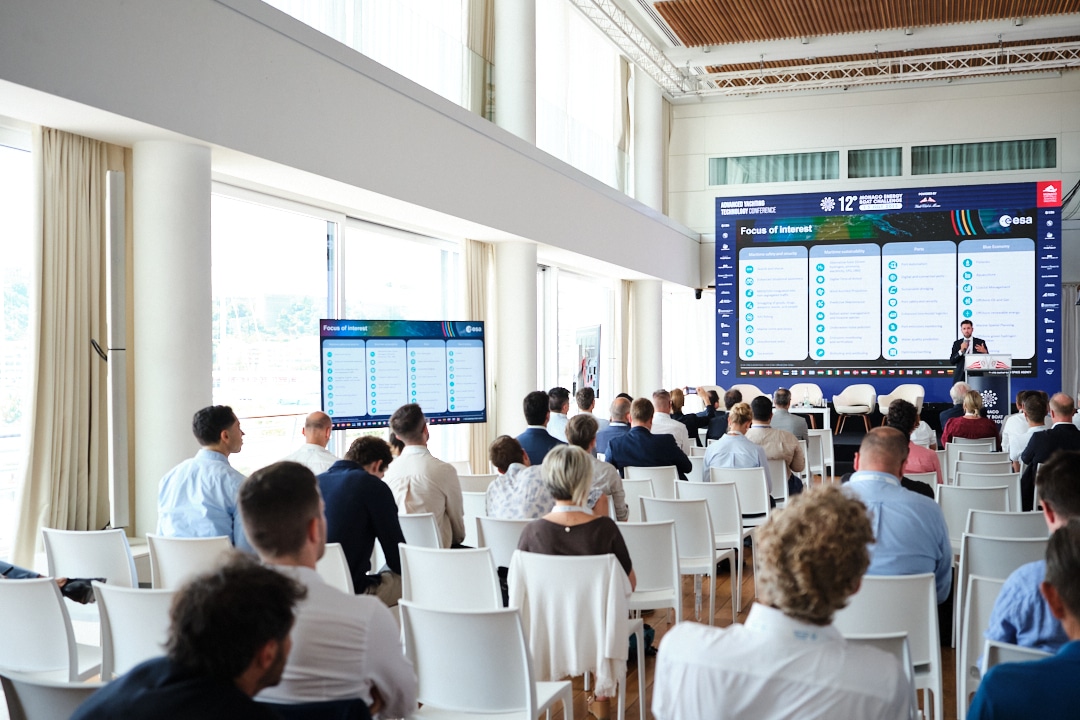
From propeller design to operational optimisation, there are many levers to improve energy efficiency on yachts provided they are mobilised consistently. On stage, five experts from the yachting industry and management shared their experience. Riccardo Repetto, Global Vessel Type Responsible – Yacht Sales Specialist, ABB Marine and Ports, opened the discussion with a presentation on the latest advance in propulsion inspired by biomimicry. ABB has developed a cycloidal propeller the movement of which is inspired by the tails of fishes and marine mammals, achieving efficiencies close to 80%. “We need to think outside the box, we can’t keep doing what we’ve done for the past 100 years with traditional propellers,” he said.
Regards the design of yachts, Matt Venner, Senior Naval Architect at Lateral Naval Architects detailed the tools developed by his design firm. They include collecting and analysing AIS (Automatic Identification System) data on actual vessel operations, energy audits before refit, and energy transition platforms incorporating the latest technologies, like ABB’s Dynafoil. Optimising hydrodynamics remains a key lever: “Reducing resistance underwater reduces the power required and therefore emissions,” he said.
Alexandre Caizergues, CEO of Syrocco, presented the digital route optimisation solution developed by his company. Based on a digital twin of the vessel and advanced weather calculations, the platform enables crews to choose the most efficient route. “The average saving on fuel observed by our customers is 10% a year, peaking at 25% depending on the routes,” he explained.
For refit and operations, Arthur Bohr, Site and Key Account Director at Monaco Marine, stressed the importance of bespoke energy audits: “Each yacht is unique. Analysis is required to identify losses and areas for improvement, particularly with regards to hospitality consumption which accounts for up to 70% of energy used on board,” he said. Finally, Jean-Jacques Boude, Head of Yacht Management at V.Ships highlighted the key role crew members play. In his view, monitoring practices, training, real time tracking systems and KPIs are becoming essential. “We’ve seen significant savings just by changing crew behaviour,” he said.
While technologies exist, lack of shared data, reluctance of some owners, and investment costs are hampering their take-up. All agreed that collecting reliable data, involving crews and being inspired by best practices in other industry sectors are indispensable to progress yachting in terms of energy efficiency.
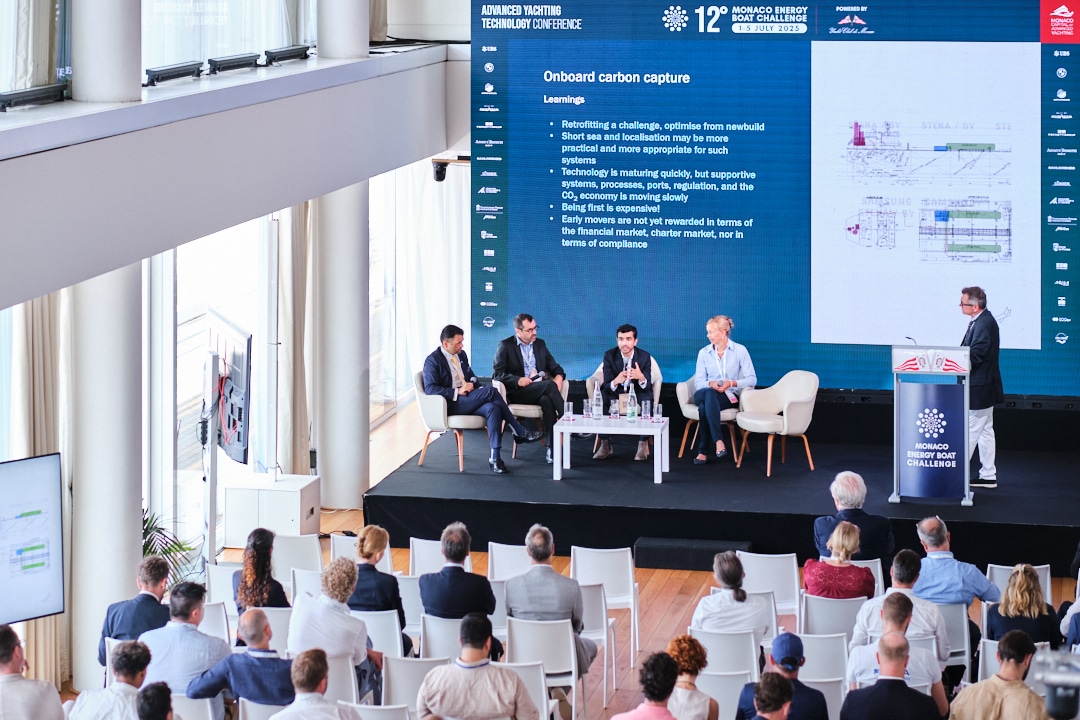
Nil Angli, BASS Maritime Lead at the European Space Agency highlighted links between the space and shipping sectors: “When you’re at sea, outside Exclusive Economic Zones, you are physically closer to the International Space Station’s orbit than the coast,” he pointed out. For several years, the European Space Agency has been supporting development of solutions that integrate satellite data to improve safety, performance and sustainability. It funds innovations by SMEs, start-ups and industrial groups provided they are making use of space technologies such as satellite communications, Earth observation, weather, emissions monitoring or route optimisation. A call for projects focusing on decarbonisation has just closed. The focus was on route optimisation, automation of ports and vessel autonomy, for example like the project called AWAKE AI where ABB and Wallenius Marine are working together to optimise the port chain.
Artificial intelligence is fast becoming a key driver at the crossroads of the maritime and automobile sectors. Experts and industry leaders shared their vision of a transformation that is not just hype. Sergio Savaresi, Professor at the Politecnico di Milano, opened the debate
with a review of major trends shaking up the automobile sector. “This revolution will only happen if self-drive technology, in other words AI applied to physical systems, is deployed,” he explained. The transition requires massive electrification, a drastic reduction in number of vehicles on the road, and new challenges related to cybersecurity and technological sovereignty.
AI applications are also increasing in the maritime sector but in sector-specific ways. Jevon Philip Chan, Senior Technology Engineer at the American Bureau of Shipping stressed that it’s “not a simple case of copy and paste from the automobile world”. The challenge is the operational complexity, the diverse types of vessel, and a need to set clear safety criteria without looking to totally eliminate the presence of a human on board. The primary aim is to reduce the cognitive load on crews and improve safety.
Filippo Belcecchi, Engineering Manager at Ferretti Group, reiterated that the first step was to collect and exploit onboard data: “Most important is to retrieve data from sensors on board in real time and in a secure way,” he said. That’s why Ferretti is working to connect its yachts to the cloud while conducting in-depth legal work to regulate the use of owners’ data. He recognises that yachting lags behind the automobile sector, but believes AI is essential to improve efficiency and reduce the carbon footprint.
Kevin Daffey, Vice-President Mobile Automation at Rolls-Royce Solutions, presented several AI applications in use, such as detecting engine anomalies and predictive maintenance. He also discussed the limitations for the maritime sector given its complexity where limited series and numerous suppliers make it difficult to consolidate data. “In industries like aeronautics, there is a clearly defined and centralised data value chain that makes thing easier. In yachting, it’s more fragmented, but the European regulatory framework is evolving in the right way”.
While the possibilities with AI are vast, it cannot be deployed without a clear data, security and ethics framework. Above all, the human element must remain at the centre of decision-making. “AI is a tool, not an end in itself. It must support humans, not replace them,” concluded Filippo Belcecchi.
Long considered to be a secondary issue compared to the environmental challenges, cybersecurity is emerging as central to security and reliability. Andrzej Gab, Director Maritime Cybersecurity Hub at EY opened the discussion by pointing out that modern yachts are hubs of connected technologies. “Every yacht has dozens of processors, computers and networks on board. Cyber threats aren’t going to disappear, they are going to increase,” he predicts, highlighting the growing risk of ransomware attacks and of navigation systems being compromised.
Luca Carra, Marine Automation & Cybersecurity Product Manager at RINA Marine Consulting, added that cybersecurity is no longer a simple add-on. It must be integrated from the start with the design: “Modern yachting is an ultra-connected ecosystem, way beyond being a floating object. Cybersecurity should be part of a yacht’s DNA from the earliest design stages”. He drew attention to the proliferation of equipment onboard giving hackers a much bigger surface to drill down into. The need for a strict separation between the passenger and ship networks was also emphasised. This is a fundamental principle for limiting the risk of intrusion via personal devices on board, such as the smartphones of crew members.
On the technology front, Karlo Džafić, R&D Engineer at the University of Rijeka, presented the work of his Artera Robotics start-up which explores hardware solutions to reinforce data security on board. He’s focusing on quantum encryption and decentralised communication protocols. In his view, new threats require another approach: “It’s not enough to make passwords more complex, quantum computers will quickly get past that type of protection,” he explained.
Yet technology alone is not enough. Tom Walters, Partner at HFW, reminded the audience that human error is still the most frequent problem: “Crew members are often the weak link. If systems are slowing down their work, they try to work around them”. That’s why he says it’s vital to have emergency plans, regular drills, intrusion tests and appropriate training. He also stressed the sometimes little-known legal aspects, for example, in the event of a ransomware attack, some legislations forbid ransoms to be paid.
All are agreed on one point: given the increasing complexity of systems on board, a comprehensive collective approach is required to ensure resilience. Designers, shipyards, owners, suppliers and crew need to be involved from the start. “Cybersecurity is not just about protecting a yacht from hackers, but also from involuntary mistakes, technical flaws and usage patterns. We need to create a shared culture from construction through the whole operational life of a yacht,” concluded Andrzej Gab.
During discussions it became clear that technological, energy and regulatory drivers are there but their effectiveness depends on the industry working together, breaking down barriers and accelerating their deployment. Yachting will not escape the demands for
efficiency and performance that is required across the maritime transport sector. Innovation combined with commitment and pragmatism has never been so important.